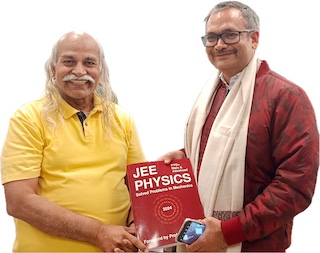Laser light is polarized
The light from an ordinary source such as sun, incandescent bulb, candle etc is unpolarized. This means that the electric-field keeps changing its direction randomly in the plane perpendicular to the direction of propagation. But laser light from the laser torch is linearly polarized. To investigate the polarization properties one uses polarizing sheets. In these sheets the molecules are arranged in such a way that they absorb light if the vibration of electric-field is parallel to one particular direction in the sheet and allows light if the vibration of electric-field is perpendicular to this direction. If the linearly polarized light is made to fall perpendicular on a polarizer sheet and sheet is rotated in its plane, the intensity of transmitted light varies between almost zero to a maximum.
You need a laser torch and a polarizer.
Fix the laser torch in a stand. Let the beam fall on the wall or on the roof. Bring the polarizing sheet in front of the laser torch. The light passes through the sheet and then falls on the wall. Now rotate the sheet in its own plane slowly and look at the intensity of the spot. At certain orientation, you will find that the intensity falls to a very low value. As the sheet is rotated in either direction from such a position, the intensity increase and becomes maximum, when the sheet is kept at 90 degree from the minimum intensity position.
This shows that laser light is polarized. Repeat the exercise after replacing laser torch by an ordinary torch. You will see that the intensity of the transmitted light does not change as the sheet is rotated. Accordingly, light from ordinary torch is unpolarized.
Variant: Variation of intensity of laser in water as seen from above and from a side
If a laser beam is going in water (having some scattering centers such as soap particles) we can see it. This is due to scattering of light. But scattering intensity in a particular direction depends on the direction of polarization ( E-field). This experiment illustrates this fact very nicely.
You need a cubic glass vessel, water, dettol, dropper, laser in a stand.
- Put some water (say half the height of the vessel) in the vessel and mix few drops of dettol.
- Put on the laser torch and let the light beam pass through the water horizontally.
- Place two observers A and B, one looking at the beam from above and the other through a side surface.
- Now slowly rotate the laser torch in its stand about its own axis so that the beam direction is not disturbed. Ask observer A when does he/she finds the beam most intense. Ask B, if he/she also finds it most intense in this situation. Write your conclusions.
- Now send the beam at about 45 degree to the water surface. What changes occur when you rotate the laser torch?
When light beam is scattered from suspended particles, the direction of E-field of the incident beam decides the direction in which most of the scattered light will go.
If light is going in x-direction and the E-field is in z-direction, the atomic dipole moments of the scattering particles will be set in vibrations in z-direction. These will emit light (scattered light) preferentially in z-direction. So the eye in z-direction will see an intense beam whereas the eye in y-direction will not see it.
Related
Subscribe to our channel
